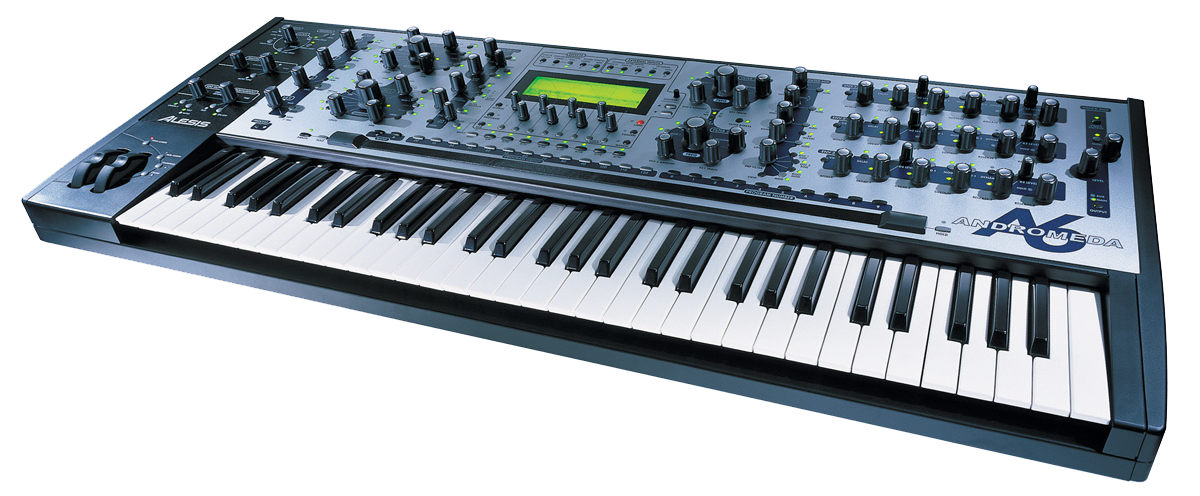A newcomer on the scene, the Summit is the Novation Peak’s bigger sibling, with more polyphony and a generous keyboard for playing epic sounds in realtime. Its Oxford oscillators are digital, and based on a new design that recreates much of the magic of pure analog, without the more annoying quirks of true analog. Its signal path after the oscillators is all analog though, and that gives it a special character untouched by any other. Trance artists who use this will certainly stand in a class of their own with this synth.
Polyphony - 16 note polyphony (dependent on voices used per note). 2-part-timbral. Layered, Split, Dual Bi-Timbral Modes. 5 Voice Modes - Mono, MonoLG, Mono2, Poly, Poly2
Oscillators - 3 oscillators, 1 noise generator with HP filter control, 1 ring modulator, 2 LFOs, 1 amp envelope and 2 mod envelopes (ADHSR + looping), 1 filter
Waveforms - Sine, tri, sawtooth, square / pulse, plus 43 wavetables of 5 waveforms per row
Filter - 1 state variable OTA filter per voice, 12/24dB slope, Low-pass / band-pass / high-pass / dual filter (separation of each 12dB filters), dual filter: LP > HP, LP > BP, HP > BP, LP + HP, LP + BP, HP + BP, LP + LP, BP + BP, and HP + HP, Pre-filter overdrive, Post-filter distortion
Modulation - 16 modulation slots per patch, 2 sources per destination per slot
Mod Sources - Direct (depth), Modulation wheel, Aftertouch (polyphonic and channel AT), Expression pedal 1, Expression pedal 2, Keyboard velocity, LFO1 positive, LFO1 bi-polar, LFO2 positive, LFO2 bi-polar, Amp envelope, Mod envelope 1, Mod envelope 2, Animate 1, Animate 2, CV mod input bi-polar, Bend Up, Bend Down
Mod Destinations - Oscillator 1-3 frequency, v-sync level, shape amount and level, Noise source level, Ring modulator output level, Overall synth output level, Filter drive, distortion, cut-off frequency and resonance, LFO 1 and 2 frequency, Amp env / mod env 1 / mod env 2 attack, decay and release, FM Osc 1 -> osc 2, osc 2 -> osc 3, osc 3 -> osc 1 and noise -> osc 1, Osc 3 -> filter cutoff frequency, Noise -> filter cutoff frequency
Effects - FX are per part, Analogue distortion, 3 chorus types, Delay with 16 types of delay sync, LP and HP damping, slew and stereo
FX Mod Matrix Source - Direct (depth), Mod wheel, Aftertouch, Expression pedal 1, Expression/breath pedal 2, Velocity, Keyboard, LFO 1 +/-, LFO 2 +/-, LFO 3 +/-, LFO 4 +/-, Amp envelope, Mod envelope 1 & 2, Animate 1 & 2, CV +/-, Bendwheel +/-, Bend up, Bend down
FX Mod Matrix Destinations - Distortion level, Chorus level, Chorus rate, Chorus depth, Chorus feedback, Delay level, Delay time, Delay feedback, Reverb level, Reverb time, Reverb low pass, Reverb high pass
Misc - FM controls on front panel, Global LFO 3 & 4, Arpeggiator with key latch – 33 patterns. Patch storage - up to 512 on hardware (ships with 256 factory patches). All knobs (excl. volume), sliders and most buttons transmit and receive MIDI cc commands for external control and mapping. Microtuning with Scala table import and table tuning creation. Manual mode. Multi pot mode: Relative, Pot pick-up, Snap



















